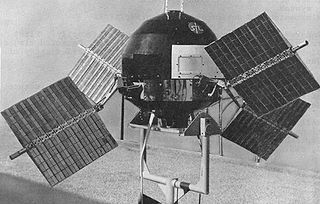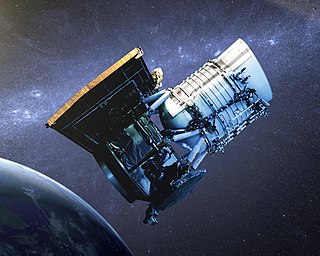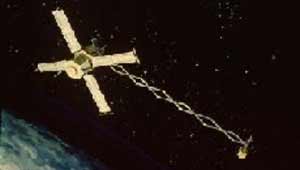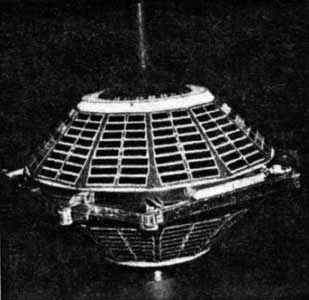
The Explorers program is a NASA exploration program that provides flight opportunities for physics, geophysics, heliophysics, and astrophysics investigations from space. Launched in 1958, Explorer 1 was the first spacecraft of the United States to achieve orbit. Over 90 space missions have been launched since. Starting with Explorer 6, it has been operated by NASA, with regular collaboration with a variety of other institutions, including many international partners.

Explorer 1 was the first satellite launched by the United States in 1958 and was part of the U.S. participation in the International Geophysical Year (IGY). The mission followed the first two satellites the previous year; the Soviet Union's Sputnik 1 and Sputnik 2, beginning the Cold War Space Race between the two nations.

Pioneer 4 was an American spin-stabilized uncrewed spacecraft launched as part of the Pioneer program on a lunar flyby trajectory and into a heliocentric orbit making it the first probe of the United States to escape from the Earth's gravity. Launched on March 3, 1959, it carried a payload similar to Pioneer 3: a lunar radiation environment experiment using a Geiger–Müller tube detector and a lunar photography experiment. It passed within 58,983 km (36,650 mi) of the Moon's surface. However, Pioneer 4 did not come close enough to trigger its photoelectric sensor. The spacecraft was still in solar orbit as of 1969. It was the only successful lunar probe launched by the U.S. in 12 attempts between 1958 and 1963; only in 1964 would Ranger 7 surpass its success by accomplishing all of its mission objectives.

A gravity assist, gravity assist maneuver, swing-by, or generally a gravitational slingshot in orbital mechanics, is a type of spaceflight flyby which makes use of the relative movement and gravity of a planet or other astronomical object to alter the path and speed of a spacecraft, typically to save propellant and reduce expense.
Explorer 3 was an American artificial satellite launched into medium Earth orbit in 1958. It was the second successful launch in the Explorer program, and was nearly identical to the first U.S. satellite Explorer 1 in its design and mission.

Explorer 6, or S-2, was a NASA satellite, launched on 7 August 1959, at 14:24:20 GMT. It was a small, spheroidal satellite designed to study trapped radiation of various energies, galactic cosmic rays, geomagnetism, radio propagation in the upper atmosphere, and the flux of micrometeorites. It also tested a scanning device designed for photographing the Earth's cloud cover. On 14 August 1959, Explorer 6 took the first photos of Earth from a satellite.

Explorer 7 was a NASA satellite launched on 13 October 1959, at 15:30:04 GMT, by a Juno II launch vehicle from Cape Canaveral Air Force Station (CCAFS) to an orbit of 573 × 1,073 km (356 × 667 mi) and inclination of 50.27°. It was designed to measure solar X-ray and Lyman-alpha flux, trapped energetic particles, and heavy primary cosmic rays. Secondary objectives included collecting data on micrometeoroid penetration, molecular sputtering and studying the Earth-atmosphere heat balance.
Lockheed Martin Space is one of the four major business divisions of Lockheed Martin. It has its headquarters in Littleton, Colorado, with additional sites in Valley Forge, Pennsylvania; Sunnyvale, California; Santa Cruz, California; Huntsville, Alabama; and elsewhere in the United States and United Kingdom. The division currently employs about 20,000 people, and its most notable products are commercial and military satellites, space probes, missile defense systems, NASA's Orion spacecraft, and the Space Shuttle external tank.

Juno is a NASA space probe orbiting the planet Jupiter. It was built by Lockheed Martin and is operated by NASA's Jet Propulsion Laboratory. The spacecraft was launched from Cape Canaveral Air Force Station on August 5, 2011 UTC, as part of the New Frontiers program. Juno entered a polar orbit of Jupiter on July 5, 2016, UTC, to begin a scientific investigation of the planet. After completing its mission, Juno will be intentionally deorbited into Jupiter's atmosphere.

Time History of Events and Macroscale Interactions during Substorms (THEMIS) mission began in February 2007 as a constellation of five NASA satellites to study energy releases from Earth's magnetosphere known as substorms, magnetic phenomena that intensify auroras near Earth's poles. The name of the mission is an acronym alluding to the Titan Themis.

Wide-field Infrared Survey Explorer is a NASA infrared astronomy space telescope in the Explorers Program launched in December 2009. WISE discovered thousands of minor planets and numerous star clusters. Its observations also supported the discovery of the first Y-type brown dwarf and Earth trojan asteroid. WISE performed an all-sky astronomical survey with images in 3.4, 4.6, 12 and 22 μm wavelength range bands, over ten months using a 40 cm (16 in) diameter infrared telescope in Earth orbit.

Magsat was a NASA/USGS spacecraft, launched on 30 October 1979. The mission was to map the Earth's magnetic field, the satellite had two magnetometers. The scalar and vector magnetometers gave Magsat a capability beyond that of any previous spacecraft. Extended by a telescoping boom, the magnetometers were distanced from the magnetic field created by the satellite and its electronics. The satellite carried two magnetometers, a three-axis fluxgate magnetometer for determining the strength and direction of magnetic fields, and an ion-vapor/vector magnetometer for determining the magnetic field caused by the vector magnetometer itself. Magsat is considered to be one of the more important Science/Earth orbiting satellites launched; the data it accumulated is still being used, particularly in linking new satellite data to past observations.

Explorer 9, known as S-56A before launch, was a NASA satellite which was launched in February 1961 to study the density and composition of the upper thermosphere and lower exosphere. It was a reflight of the failed Explorer S-56 mission, and consisted of a 7 kg (15 lb), 3.66 m (12.0 ft) balloon which was deployed into a medium Earth orbit. The mission was conducted by NASA's Langley Research Center.

Explorer S-45 was a NASA satellite, which was lost in a launch failure in February 1961. The satellite was intended to operate in a highly elliptical orbit, from which it was to have provided data on the shape of the ionosphere, and on the Earth's magnetic field. It was part of the Explorer program, and would have been designated Explorer 10 had it reached orbit. A second identical satellite, Explorer S-45A, also failed to achieve orbit when it was launched.

Explorer S-45A was a NASA satellite, which was lost in a launch failure in 1961. The satellite was intended to operate in a highly elliptical orbit, from which it was to have provided data on the shape of the ionosphere, and on the Earth's magnetic field. It was part of the Explorer program and would have been designated Explorer 12 had it reached orbit. It was the second of two identical satellites to be launched; the first, Explorer S-45, had also been lost in a launch failure, earlier in the year.
Kosmos 167, or 4V-1 No.311, was a 1967 Soviet spacecraft intended to explore Venus. A spacecraft launched as part of the Venera programme, Kosmos 167 was intended to land on Venus but never departed low Earth orbit due to a launch failure.

The Europa Lander is a proposed astrobiology mission concept by NASA to send a lander to Europa, an icy moon of Jupiter. If funded and developed as a large strategic science mission, it would be launched in 2027 to complement the studies by the Europa Clipper orbiter mission and perform analyses on site.

Explorer S-46 was a NASA satellite with a mass of 41 kg (90 lb). It was the last of the original series of Explorer satellites built, designed, and operated by the Jet Propulsion Laboratory and Army Ballistic Missile Agency (ABMA).

Explorer 60, also called as SAGE and was the second of the Applications Explorer Missions (AEM), AEM-B, was a NASA scientific satellite launched on 18 February 1979, from Wallops Flight Facility (WFF) by a Scout D-1 launch vehicle.
















